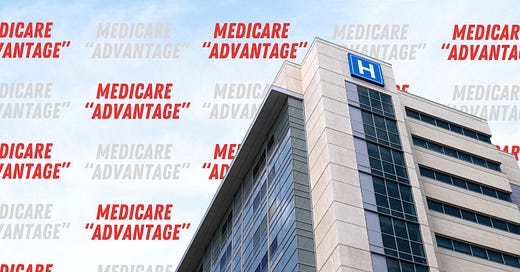

Discover more from HEALTH CARE un-covered
Hospital megasystems join insurers in a pattern of mergers and acquisitions, patients pay the price.
Now that President Biden has signed the Inflation Reduction Act, which authorizes Medicare to negotiate directly with pharmaceutical companies for some drugs, you can expect policymakers and reporters to shift their focus to the high cost of a stay in the hospital. That coverage must also include how health insurers are forcing millions of Americans to pay thousands of dollars out of their own pockets before their insurers will cover any of their hospital bills.
This past weekend, the New York Times published an investigative piece, long in the works, that details how Providence, the country’s largest tax-exempt hospital system, paid McKinsey & Company tens of millions of dollars to write scripts for employees to use to get as much money as possible from poor and middle-class patients, including those who shouldn’t have been billed in the first place.
“Ask every patient, every time,” the [McKinsey] materials said. Instead of using “weak” phrases — like “Would you mind paying?” — employees were told to ask how patients wanted to pay. Soliciting money “is part of your role. It’s not an option.”
If patients did not pay, Providence sent debt collectors to pursue them.
Long overdue scrutiny
The Times report came three days after Washington Monthly published veteran journalist Shannon Brownlee’s review of the new book Big Med, which explores the consequences of hundreds of mergers over the past few years that have created huge hospital monopolies. As Brownlee wrote:
The authors argue that there’s no evidence that megasystems are consistently providing higher-quality care than stand-alone hospitals, and they are no less wasteful, and certainly no less expensive, than smaller institutions. Neither vertical integration nor horizontal mergers have brought down costs or led to higher-quality care.
FULL DISCLOSURE: I was one of many people, including Brownlee and many other health policy experts as well as patients, who were interviewed for American Hospitals: Healing a Broken System, an upcoming documentary about the unequal fortunes of U.S. hospitals. Many megasystems are sitting on billions of dollars in reserves–which they all too often use to build new facilities in rich neighborhoods–while hundreds of smaller hospitals that serve rural areas and poor city neighborhoods have closed or are in danger of closing.
One of the things I note in the documentary is that the frenetic pace of hospital mergers has been driven to a large extent by rapid and continuing consolidation among health insurers. As insurers bulked up, hospitals and other providers felt they had no alternative but to follow suit to maintain some leverage at the negotiating table with insurers.
The patients interviewed for American Hospitals, by the way, have health insurance, but their deductibles are unconscionably high. One woman describes how she had to sell her home after a stay in the hospital because she couldn’t afford the thousands of dollars her insurer insisted she had to pay before her coverage kicked in.
Another patient, a recently married young man, was forced into bankruptcy because he couldn’t meet his health plan’s out-of-pocket requirements. (I’ll write more about the movie in the coming weeks ahead of its official release.)
FIG LEAF INSURANCE: Both of those patients are among the millions of Americans who are now functionally uninsured because of the high deductibles, copayments, and coinsurance they’re obligated to pay at the pharmacy counter, doctor’s office, or hospital admission desk. These are people who are paying a lot in premiums for coverage that doesn’t come close to protecting them and their families from financial ruin.
Brownlee suggests–as the documentary does–that many hospitals operating on the edge might soon encourage their state lawmakers to follow Maryland’s lead of establishing “global budgets” for all of a state’s hospitals. Maryland’s approach is clearly working. Global budgeting and other cost-control features that Maryland has put in place have resulted in considerably lower health care inflation–and improved access to care–than in other states. And the hospitals that serve rural and poor patients are able to keep their doors open.
As policymakers and the media set their sights on big hospital systems, they must also investigate health insurers’ massive profits that are made possible in part because of the out-of-pockets most privately insured Americans must now pay in addition to their ever-increasing premiums.
Policymakers need to know that many U.S. hospitals are closing because more and more of their privately insured patients can’t pay their portion of their medical bills. As Modern Healthcare reported last month, insured patients have become the top reason for bad debt at hospitals and other health care providers. According to the report:
Health systems are navigating rising costs in the face of fewer payments from patients who are increasingly turning to high-deductible plans they can’t afford.
If you are in a high-deductible plan you can’t afford, let us know. We want to help tell your story.











To share some numbers around the OOP Max problem.... where I live, *all* but one of the (Un)Affordable Care Act plans features the maximum "OOP Max" allowed by law as the deductible. For the 2022 plan year, the out-of-pocket limit for a Marketplace plan can’t be more than $8,700 for an individual and $17,400 for a family. The one that doesn't costs something like $2K per month for an individual - so, for most of us, effectively none. For most people, that means they have only "super-catastrophe" coverage. People with this coverage and who have an expensive ongoing or chronic condition face a "catastrophe" every year. I gather that the OOP-max-as-deductible is not the case everywhere and I would *love* to know how the community deductible is determined, especially where there is such unwavering consistency.